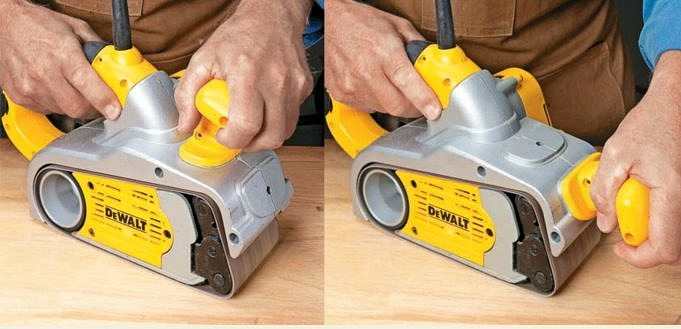Grinding, rough finish polishing and sanding can be difficult tasks that you will have to perform in many woodworking projects. The good news is, theres a power tool that does almost all of the work for you! It is also very easy to use. If youre working with wood, steel, laminate, or if you do a lot of grinding, a belt sander is the tool you have to have. Keep reading to find out how to choose a belt sander.
Before we begin, are you looking for some general information on tools like miters saws, chainsaws, table saws, etc? Check out our complete resource guides on Miter Saws, Table Saws, Chainsaws, Band Saws, and Circular Saws.
What Are Belt Sanders?
The belt sander, a handheld power tool, is used to quickly smoothen, shape or remove large amounts of material. They can be used on both small and large projects like removing paint, sanding a deck, sanding hardwood furniture, and other woodworking projects. The belt sander is made up of a large loop of sandpaper, usually between 8 and 10 cm in width. It spins around two rollers with a large flat working surface.
A belt sander is perfect for ant projects that require you to sand large areas, this is because it has a powerful motor that removes material quickly especially if youre using a rough grit sandpaper. For projects that require quick smoothing or finishing large areas, fine grit sandpaper works well.
While most commonly used for wood, belt sanders can also be used to remove paint and rust. I would like to mention that you need to be sure that you use a sanding belt that is designed for metal and that you first empty and remove the dust collector before starting so you dont start a fire.
Belt sanders are great at removing excess material. This could be on doors or countertops. Belt sanders are a very powerful tool and if its not used carefully, it can take off more material than intended. Be sure to take this into consideration when youre picking the grit level of the sandpaper.
How Do You Choose The Best Belt Sander?
A wide belt, usually 3 inches wide, is the best choice for a belt sander. Belt sanders are sold with wider and narrower belts. However, these are only for specific tasks.
- There are also smaller tools that can be used with the 3 in belt sander class. These smaller tools can take 3 x18 in. There are three sizes of belt sanders: small machines that can take 3×18 in belts; medium-sized machines that can take 3×21 in belts; and large belt sanders which can take 3×24 in. belts. Because you can use them one handed for shaping and scribing, the smaller tools are easier to carry and use. These are best for casual use and smaller work.
- The larger belt sanders have more weight and surface area which makes them great for smoothing wide surfaces. These sanders are best for larger projects and shop use. The 3 x 21 in. Belt sanders make a great compromise.
- Youll find 3 x 18 in. belt sanders from to and 3 x 21 in. belt sanders for to
- There are also smaller sanders with a 2-inch length. wide belts. Theyre great for one-handed use and light. 4-in. Sanders wide belts are the heavy-duty machines that are best for cabinetmakers.
How To Use A Belt Sander
Do not push the sander down. Let the machine’s weight do all the work. Slowly move the tool, allowing it to reach the end without having to dip or overlap. Be mindful not to change speed or direction or dip the sander. Be sure to put the cord of the machine over your shoulder so its out of the way.
Belt Sander Maintenance
First, make sure the belt on the sander is oriented properly. Some belts have a specific direction. This is indicated on the machine’s inside by an arrow. Belts sanders that are nondirectional can be installed either way. The only adjustment youll have to make is to keep the sanders belt centered. Hold the belt sander up, turn it on, and see if the belt either starts working its way off the rollers or rubs against the housing. Adjust the tracking knob so that the belt is perfectly centered on the rollers.
Keep Your Belt Clean
Dirty belts are not good for your health. The belt-cleaning tool will help remove any buildup. Push the sander against the moving belt, if you have a larger sander, clamp the stick in a vise and sand it.
Belt Sander Safety Tips
Although belt sanders can be used safely, it is important to take precautions.
- Wear hearing protection-belt sanders are LOUD!
- Use a dust mask. Dust is not only irritating to your lungs, but it can also be harmful for your health. Wear a mask while sanding, unless you rig up a shop vac for dust collection.
- Before you empty the dust bag or change belts, unplug the tool.
- If you use the belt sander to sand metal, youll get sparks. If the sawdust in the dust bag and the belt sander mix, sparks can ignite a fire. Before you start using the belt sander on metal, vacuum the dust or blow it out.
- Make sure the trigger on the sander is off before plugging it in. Belt sanders come with a lock button to keep the trigger in the on position. You dont want the sander to fly across the room when you plug it in.
- Belt sanders have a lot of force meaning if your work isnt secure, itll slide right into you or away from you.
Wrapping Up
Theres How to Choose a Belt Sander! This guide should have helped you choose the right belt sander. Do you own a belt sander already? Are you thinking of buying one? We would love to hear your thoughts!



